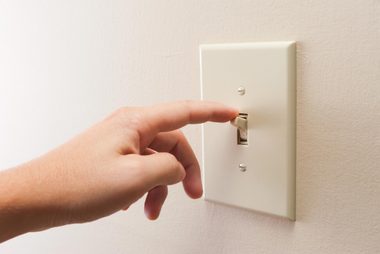
Put them to bed earlier
Some parents assume that keeping their child up late will exhaust them, helping them to fall asleep more easily and making toddler sleep training an easier task. Not so, says Elizabeth Pantley, author of No-Cry Sleep Solution. “An energetic child may appear to be running on full steam until late in the evening. But a toddler who stays awake until 9 or 10 p.m. often is ready for bed many hours earlier, and is up late functioning on overdrive—often indicated by fussiness or hyperactivity.” Implementing an earlier bedtime could not only make bedtime a little easier, research suggests it’s best for your child. “Studies have shown that a child’s blood pressure, heart rate, and release of cortisol (a stress-regulated hormone) are all affected in a positive way by an early bedtime,” Pantley explains.

Turn off the lights
Many toddlers need help winding down for the night before they head off to bed. “Try to start decreasing your child’s exposure to light about 60 minutes before bedtime, as lots of light at this time can negatively affect circadian rhythms, or internal sleep clock,” says Kevin Smith, PhD, clinical psychologist at Children’s Mercy Kansas City. “This is especially true for electronics with screens (e.g. tablets, televisions, computers). Research shows that electronics usage right before bedtime or while in bed actually can make it harder for your child to fall asleep in the long run.” Of course, don’t assume your child needs complete darkness to fall asleep. Dr. Smith suggests a small nightlight or projector light for a toddler who is afraid of the dark. Are you the one having trouble falling asleep? Here are daily habits to follow for a better night’s sleep.

Keep it quiet
Parents should focus on creating a positive sleep environment for their child, including keeping it quiet. “Some children seem more sensitive than others when it comes to noise at night,” Dr. Smith says. “Unfortunately, for some families, that means tiptoeing around the house for a few hours after their little one goes to bed—not a very practical or enjoyable solution. If this is a challenge for your family, try desensitizing your child to noise by slowly introducing relaxing background noises in their bedroom such as a fan, white noise machine, or soft relaxing music.” The use of a sound machine can not only help your child become less sensitive to noise, but also help drown out noise from the rest of the family and any noise coming off the street. (Don’t miss these 22 ways you’re sleeping all wrong.)

Have a bedtime routine
Children need routine and consistency to help them feel secure, according to Pantley. Without a consistent bedtime routine, bedtime can become an emotional and unpredictable experience for everyone involved and may result in a toddler not wanting to go to sleep. “Never knowing when you’ll be getting your child ready for bed, how long the process will take, or what time your child will sleep can make it difficult for you to feel in control of your day, and your child may have a meltdown by day’s end before you’ve even begun the bedtime process,” Pantley warns. “The convenience and the stability of a regular bedtime routine is an important touchstone for the day.” Looking for a few books to include in your child’s bedtime routine? Here are over 15 of the best books to read as a kid.

Let them nap
While it may seem logical to withhold a nap from a child who isn’t sleeping well at night, a lot of toddlers really need their naps to function well, according to Pantley. “Children have a natural dip in energy and alertness at mid-day, even after a full night’s sleep, and a nap that corresponds with this dip follows a child’s natural biological need for rest,” she says. “A mid-day nap enables the body to release hormones that combat daily stress and tension, and the benefits last right up until bedtime.” By the way, you should be napping, too! Find out the 10 amazing things that happen to your body when you take an afternoon nap.

Keep bedtime reads soothing
Most parents know just how important daily reading can be for developing minds, but what you read before bed matters, according to Rebecca Bevans, PhD, psychology professor at Southern New Hampshire University. “Action and adventure books can activate a child’s imagination, or cause some increase in anxiety, and that can lead to a difficult transition to sleep. Choose to read calm, relaxing books at bedtime,” suggests Dr. Beavns.

Help them relax
While many children fall asleep easily at this age, especially after a busy day, Jack Maypole, MD, of The Goddard School, knows firsthand this isn’t the case for all children and gentle toddler sleep training may be necessary. “Our children tended to have the age appropriate burgeoning imaginations during toddlerhood that made shadows scary and created challenges for tucking in and having them stay in their beds,” he says. Dr. Maypole suggests that parents help their children relax by making a mini-relaxation session a part of their special bedtime routine. “We would have our children do a mindful, relaxation exercise by counting their breaths slowly, and then say goodnight to their bodies. We’d wish pleasant dreams to their feet, and have them go on to imagine saying ‘night-night’ to their legs, belly, and arms, and neck. Ultimately, we’d quietly bring them to their eyes, and perhaps set the stage for a relaxing dream to follow. Most times, it was lights out by the time we were done!”
